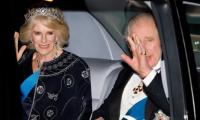After the demise of the USSR, it was widely believed by people in the West that Nato would become democratic and work for peace. But to their utter surprise, the military alliance started blitzing various states. It emerged as a potent tool to topple the governments of a few ‘dictators and autocrats’.
Reneging on their promises, Western countries also expanded the footprints of this anti-communist strategic alliance even though the socialist bloc and Eastern Europe has disintegrated. They went to the extent of knocking on Moscow’s doors.
Moscow didn’t react violently to the expanding power of the military alliance as it was grappling with the effects of its disintegration. But once it was back on its feet under the leadership of Putin, it started challenging the hegemony of Western powers that had always haunted policymakers in the power corridor of Moscow.
Russia clandestinely made efforts to protect its backyard in Central Asia by ridding it of Western influence. But regime changes in some former Soviet socialist republics where irredentist Russian leaders weren’t ready to cede more space to the West alarmed Moscow. The annexation of Crimea was a clear message to Russia’s rivals that Moscow could go to any extent to protect its area of influence.
But it seems that this influence could be threatened by the recent two-day Nato summit that ended last week in Brussels. The summit has not only vowed to rearm the alliance, but has also pledged to increase military spending. Nato is currently spending $900 billion. The member states will now spend two percent of their GDP on defence, allocating $1,500 billion towards this decades-old war machine.
According to media reports, the most immediate and tangible outcome of the summit was a Nato plan to expand the number of military forces prepared to attack Russia, or any other country, at a moment’s notice. The summit resolution declared that “allies will offer an additional 30 major naval combatants, 30 heavy or medium manoeuvre battalions, and 30 kinetic air squadrons, with enabling forces, at 30 days’ readiness or less”.
The resolution reaffirmed Nato’s moves to deploy “four multinational combat-ready battalion-sized battlegroups in Estonia, Latvia, Lithuania, and Poland”, including over 4,500 troops from across the alliance – all within hundreds of miles of St Petersburg.
Plans to create two new command headquarters were also agreed upon at the summit. One centre will be established in Norfolk, Virginia, “to focus on protecting the transatlantic lines of communication” while another will be set up in Germany to “ensure freedom of operation … in the rear area in support of the rapid movement of troops and equipment into, across, and from Europe”.
The summit resolution reaffirms the expansion of Nato’s nuclear arsenal. It declares that “as long as nuclear weapons exist, Nato will remain a nuclear alliance. The strategic forces of the alliance, particularly those of the US, are the supreme guarantee of the security of allies”. The resolution vows to continue Nato’s eastward expansion, reiterating the organisation’s plans to invite Macedonia, Ukraine and Georgia to join the anti-Russian alliance.
The resolution and its future plans are likely to make Russia more vigilant. They will add more tension to a strategic environment in Europe and elsewhere, which is already fraught with suspicion and mutual distrust. Such plans will not only push Europe towards a conflagration, but also have potential to engulf the entire world in a destructive conflict.
They will also tear the social fabric of European societies. The money for such a vast amount of spending will naturally come from the toiling masses who are already groaning under the ruthless sword of austerity across Europe. It is difficult to understand why Western countries need to pump such a huge amount into an initiative that will bring nothing but destruction.
This phenomenal increase in Nato’s military spending is being carried out by the ruling elite of the Western world to appease arms manufacturers and traders even though it will add to the woes of the working class.
Using the pretext of a financial crunch, a large number of European states have adopted austerity measures. This has led to lower wages, higher taxes, fewer state benefits and more job cuts. In Greece, this economic policy has resulted in a sharp rise in unemployment. Meanwhile, in Portugal, Spain and Italy, unemployment rates climbed to 15 percent, 25 percent and 9.8 percent, respectively. The British government made spending cuts worth 103 billion GBP until 2017, which sent the country into a double-dip recession. University tuition costs soared, provoking violent protests. Harsh spending cuts slashed government jobs by the thousands and cut funding to the police.
Rulers of Nato states that are enthusiastic about propping up this strategic alliance financially seem to have no regard for the suffering of their people. Rising unemployment rates and falling living standards have spawned far-right and fascist groups that are attacking immigrants and pushing European societies towards anarchy.
Europe is heavily dependent on Russia for its energy supply and this dependence is increasing. According to the Financial Times, Russia’s gas export to Europe rose by 8.1 percent last year to a record level of 193.9 billion cubic metres. State-run Gazprom, the world’s largest gas producer, has a monopoly over Russia’s network of pipelines to Europe and supplies close to 40 percent of Europe’s gas.
Russia also exports oil to European states. Moscow is the EU’s fourth-largest trade partner while the EU is Russia’s biggest trade partner. This trade relationship has been affected by Moscow’s tension with Ukraine. Trade continuously decreased since 2012, dropping by 44 percent between 2012 and 2016 from 339 billion euros to 191 billion euros. Moscow imports machinery, transport equipment, chemicals, medicines and manufacturing products.
Given this mutual interdependence, it will be disastrous for both Brussels and Moscow to ratchet up tension. Europe and Russia have witnessed many wars that have killed millions of people. Since Russia was invaded a number of times by European leaders – from Napoleon to Hitler – some of its security concerns are legitimate and must be heard in a serious manner. If European powers can hobnob with autocratic monarchs of the Middle East while upholding the rhetoric of democracy and human rights, why can’t they normalise ties with a fledgling democracy in Russia?
It is true that the Russia is not as democratic as we want it to be. But the democratic system of the West is not ideal either because this free world of democratic values has propped up more than 100 dictators and autocratic governments across the world over the last seven decades.
Europe believes in institutions and democratic norms. Talks and negotiation are the cardinal principles of democracy. It is prudent to employ this tool of persuasion to deal with Russia rather than send arms and tanks to the European landmass. The Western ruling elites may ride off in a blaze of glory after deciding to increase military spending, but if this policy is not scrapped, it could create a disaster for Europe and Russia.
So, what is the solution? Although European leaders resent Trump’s bristling and bickering, they should support him if he tries to strike a deal with Putin. Cordial relations between Russia and the West will save the world from another massacre. With time, China and other major powers can also join this friendship club, which might help the world liberate itself from war and conflict.
The writer is a freelance journalist.
Email: egalitarianism444@gmail.com
A health worker administers polio vaccine drops to a child during a door-to-door polio vaccination campaign in Lahore,...
Armed militants of the banned Tehreek-e-Taliban Pakistan pose for a photograph in Orakzai Agency. —...
An aeroplane of the national flag carrier of Pakistan is seen in this file photo. — AFPWhile Pakistan considers...
Representational image of a graph depicting various variables. — APP/FileInitiated by the centre and fiercely...
In this picture taken on April 16, 2023, people throng a market area during shopping in Lahore. — AFPOne of the...
Honour crimes also target men. In Sikandar Ali Lashari vs The State, SHC upheld conviction passed by ATC for honour...







